London knife crime: Can Chicago's model cure the violence?
 Alyssa Schukar
Alyssa SchukarIs it really possible to reduce violent crime by tackling it like an infectious disease?
London has announced it is to follow Scotland's public health approach to help tackle violent crime. The idea of treating crime as a disease is not new, however. It originated on the streets of Chicago more than two decades ago and has its roots in the fight against Aids in Africa.
London has already seen 100 murders this year following a surge in violence which has focussed attention on knife crime in particular.
The Mayor of London Sadiq Khan has come under increasing pressure to take action and old debates about police stop and search powers have been revived. Meanwhile, the Metropolitan Police Commissioner Cressida Dick has admitted her officers are "stretched".
It is a situation that bears similarities with the streets of Chicago 20 years ago.
Dr Gary Slutkin, an epidemiologist with the World Health Organisation, returned there in the mid 1990s after years spent fighting infectious diseases in Asia and Africa.
In Uganda he had tackled the spread of Aids with some success. However, he had become jaded by the death and misery he witnessed and was looking forward to a break.
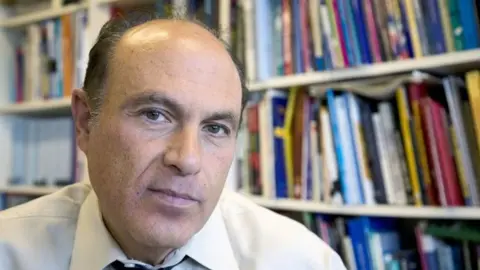 UIC
UICInstead, he was shocked by the violence and death he encountered in his homeland.
"I saw that all this violence was happening in America and I didn't even know, as I'd been away for so long, I thought America had no problems," he said.
"When I came here I saw in the newspapers and TV that there were 14 year olds shooting 13 year olds in the head. Killing them. Just little kids shooting each other. What is this?"
Between 1994 and 1999, 4,663 people were murdered in Chicago. By comparison, Los Angeles - which had a significantly higher population - had only seen 3,380 homicides.
Intrigued, Dr Slutkin began to investigate. He looked at the data and noticed a number of similarities between the violence in Chicago and the epidemics he had just spent years trying to cure.
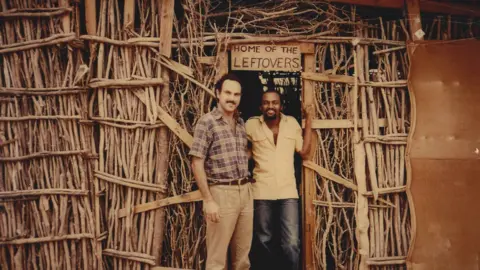 Cure Violence
Cure Violence Getty Images
Getty ImagesHe realised violent incidents were occurring in clusters at certain locations and at certain times.
Furthermore, the violence appeared to be replicating itself, similar to an infectious disease. One violent incident would lead to another and then another, and so on.
Finally, violence was increasing rapidly in a fashion very similar to an epidemic wave.
As an epidemiologist, he knew to look for three things before classing a disease as contagious; clustering, self-replication and epidemic waves.
Dr Slutkin concluded Chicago was facing an epidemic disease just as bad as he had witnessed in Uganda.
He decided to treat the problem in the same way.
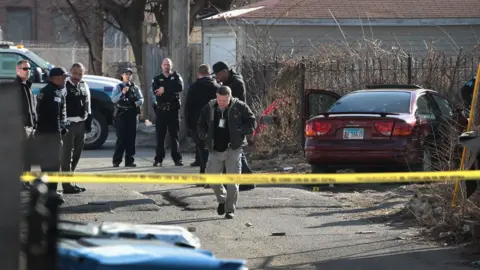 Getty Images
Getty ImagesMoved to action, he obtained funding from a local university and set up Cure Violence - a project dedicated to using public health methods to tackle violent crime.
As with the fight against Aids, the first rule was that violence should not be treated as "a problem with bad people". Instead, it would be treated as a contagion that infected people. This meant aiming to prevent violence before it broke out and mitigate it once it had.
In Uganda, Dr Slutkin and his colleagues had learned people would only listen to safe sex advice if it was delivered by their peers.
"We used people who had the same access and reach from the same population," Dr Slutkin says.
"Gay men to reach gay men, sex workers to reach sex workers."
In Chicago, he adopted a similar approach. Controversially, he recruited former gang members to educate current gang members, intervene in disputes and hopefully prevent the violence at source.
The results were instant; crime in its pilot area, West Garfield, dropped significantly. Soon the project was being adopted across other troubled parts of the city.
Key to its success were the former gang members, known as Violence Interrupters. Employed as a link between - but crucially separate from - law enforcement and the gangs, they used their community contacts to identify high-risk situations and individuals and then intervene in disputes before they escalated into violence.
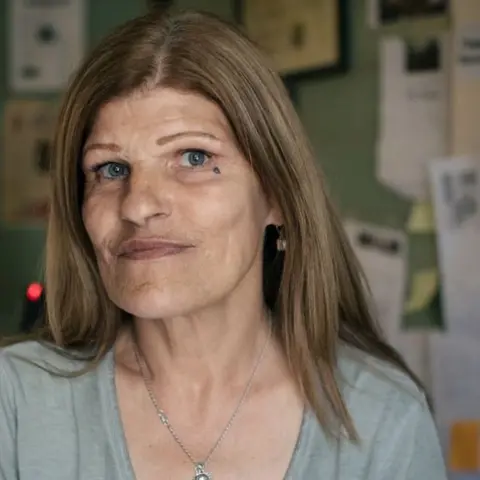 Alyssa Schukar
Alyssa SchukarAngalia Bianca was a member of the infamous Latin Kings gang for more than 30 years before becoming a violence interrupter seven years ago.
"It's all about buying time in most situations, trying to calm people down and talk them down from doing something they'll regret," she says.
"These guys out here aren't going to listen to police, but we have a reputation and a street cred.
"We used to live our lives out on the streets, gangbanging, committing crimes. We speak their language."
The impact of this community engagement approach has been significant.
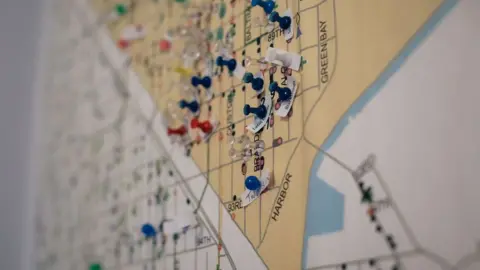 Alyssa Schukar
Alyssa SchukarSince the project began, shootings have fallen by as much as 40% in areas where violence interrupters have been present. Other cities in the United States have followed suit, most notably Los Angeles, New York and Baltimore.
In Scotland, Glasgow has adapted the approach - incorporating it into a wider public health strategy involving education, health and social services.
The city has seen its murder rate drop by more than a half between 2004 and 2017.
The success of Scotland's Violence Reduction Unit, which received £7.6m in Scottish government funding between 2008 and 2016, has now caught the eye of Mr Khan.
However, the strategy is not without its problems.
In Chicago, funding has been a perennial issue.
In 2015, Cure Violence went the first of two years without a full state budget due to a stalemate between governor Bruce Rauner and House Speaker Mike Madigan.
Dr Slutkin believes this led to a loss in lives.
"We wrote a letter and said this was going to be a disaster, in other words predicted it," he said. "We lost all of the workers for 13 communities."
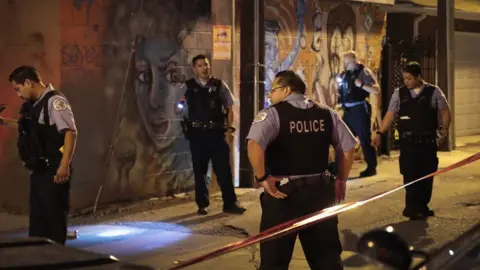 Getty Images
Getty Images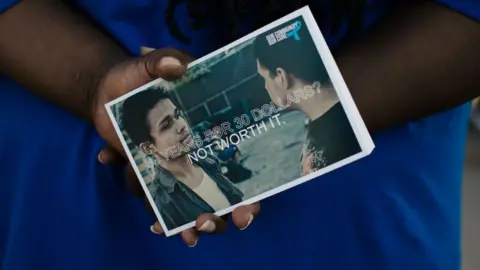 Alyssa Shuckar
Alyssa ShuckarThe following year, 771 people were murdered in Chicago - the city's deadliest year in nearly two decades. In 2017, after the Cure Violence team had regained its funding, there was a 16% decline in murders.
Over the past year, London has experienced its own surge in violent deaths.
Dr Slutkin's public health approach appears to be a catalyst to the Mayor of London diagnosing the capital's violence as a "disease".
However, there is a significant difference in scale.
This year, Cure Violence received funding of $5.4m (£4.1m) in Chicago and $17.2m (£13m) in New York.
Mr Khan has only put up £500,000 for the project in London, a figure described by criminologist Anthony Gunter as a "joke".

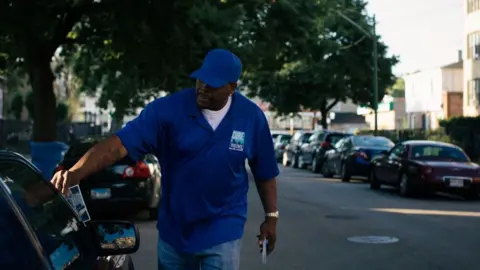 Alyssa Schukar
Alyssa SchukarHe feels the mayor has been "slow" to react to London's violence issue but is a fan of the Chicago approach, although he points out the city's murder rate remains high.
"The devil is in the detail and at this stage there isn't much detail," he says of Mr Khan's announcement.
"It needs a multi-agency approach and everyone working together. It will need Sadiq Khan to work with (home secretary) Sajid Javid."
For some communities in London, Chicago and Glasgow, violence is part of everyday life. It is part of wider social issues such as unemployment, education, broken families and drugs.
Whether Mr Khan's diagnosis of violence as a disease will make a difference remains to be seen.
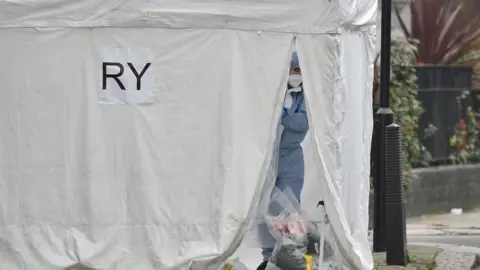 PA
PAOne person who is happy about the announcement, though, is Sarah Jones, who has been campaigning for the public health approach since being elected Labour MP for Croydon Central in 2017.
She believes violence interrupters could be key to stopping knife crime in parts of London.
"There are small groups across London which fulfil a similar role, but we need to have more people who have that respect and trust in that community," she says.
"Having someone to intervene at the point where they are thinking about being violent can make a massive difference.
"The Violence Reduction Unit is a step in the right direction, but it needs commitment from everyone in the long run."
